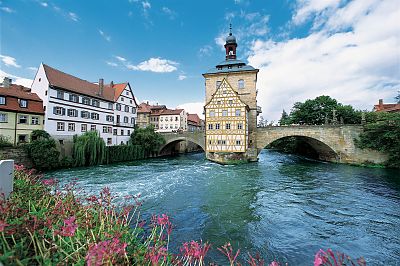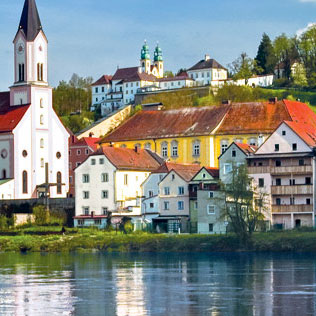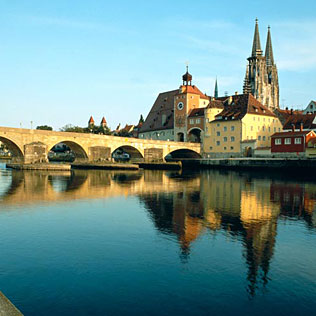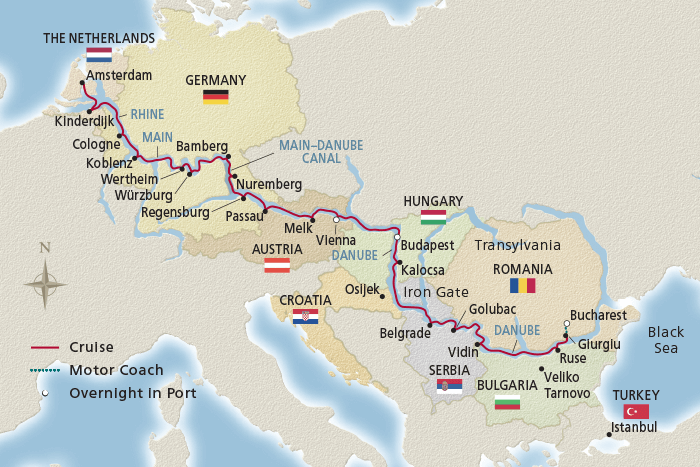Find the River Cruise you’re looking for...
23 Day Viking River Cruise from Bucharest to Amsterdam 2026

European Sojourn
River Cruise Description
Sail Amsterdam’s canals. See castles on the Rhine. Behold the grandeur of Vienna. Celebrate folk traditions in Hungary, Croatia, Serbia, Bulgaria and Romania. These travel icons—and more—await you on a 23-day journey combining our Grand European Tour and Passage to Eastern Europe cruises. Discover eight countries in Western, Central and Eastern Europe while cruising the Rhine, Main and Danube. Enjoy a lifetime’s worth of experiences on a single voyage.Get More Cruise Info
We'd love to connect with you and answer any questions you might have about this cruise. Fill out the form below and we'll get back with you pronto.
* Required fields.
(Note: either your Email or Phone is required—not both.)
| Departure Date | Ship | Priced From (per person) | |
|---|---|---|---|
| Apr 28, 2026 | Viking Lif | $9,899 | Call Us! |
| May 12, 2026 | Viking Eldir | $9,749 | Call Us! |
| May 26, 2026 | Viking Vidar | $9,899 | Call Us! |
| Jun 9, 2026 | Viking Lif | Waitlist | Call Us! |
| Jun 23, 2026 | Viking Eldir | Waitlist | Call Us! |
| Jul 7, 2026 | Viking Vidar | $8,699 | Call Us! |
| Jul 21, 2026 | Viking Lif | $8,699 | Call Us! |
| Aug 4, 2026 | Viking Eldir | $9,199 | Call Us! |
| Aug 18, 2026 | Viking Vidar | $9,499 | Call Us! |
| Sep 1, 2026 | Viking Lif | Waitlist | Call Us! |
| Sep 15, 2026 | Viking Eldir | $9,799 | Call Us! |
| Sep 29, 2026 | Viking Vidar | $9,499 | Call Us! |
| Oct 13, 2026 | Viking Lif | $9,299 | Call Us! |
| Oct 27, 2026 | Viking Eldir | Waitlist | Call Us! |
River Cruise Itinerary
Day-By-Day



Day 1 Bucharest, Romania
Arrive and check in to your hotel. Bucharest is Romania’s cultural capital. Its original fortress, the first of many, was built to protect the Walachian state from the Turks. Today, it is a city of elegant French-style boulevards, lush gardens and green expanses, including the tranquil Bucharest Botanical Garden. The historic Lipscani district exudes the old-world charms of cobblestone alleys, inns and shops. The sprawling Palace of Parliament is the world’s largest civilian building, said to contain 3,000 rooms.Day 2 Bucharest, Romania
Communism changed the face of Bucharest and has left in its wake a city brimming with imposing socialist architecture. Dotted among today’s cityscape are wonderful art nouveau buildings, ancient churches and monasteries that were rescued from the bulldozer. From the 18th-century church Schitul Maicilor to the 16th-century Mihai Vodă Church, it is best to discover these treasures on foot. Bucharest is also home to an array of world-class museums, including the George Enescu National Museum, which features a beautiful oyster-shaped glass awning. After breakfast, check out of your hotel and begin your journey to your embarkation city.Day 3 Ruse, Bulgaria
The most integral Danube city in Bulgaria, Ruse enjoys a setting amid a rolling countryside blanketed in sunflower and wheat fields. Once an outpost of the Roman Empire, it was known as Sexaginta Prista, or Sixty Ships, for the fleet that once docked here. Today, it is more known for its colorful atmosphere and as a gateway to Romania’s fabled Transylvania region. Best explored on foot, the city features many fine examples of 19th- and 20th-century neobaroque and neorococo architecture.Day 4 Vidin, Bulgaria
One of Bulgaria’s oldest riverside towns, Vidin is home to the only entirely preserved medieval Bulgarian castle. Perched impressively on the riverbank, its striking pose, thick ring walls, stout towers and solid gates form a fortress known as Babini Vidini Kuli, which means Granny Vida’s Towers. Around the castle rose a fairy-tale town of 25 minarets, domes and other charming architecture of the period. Though many of these features have been shadowed by today’s city, Vidin retains its charms. Today it is largely an agricultural and trade center renowned for its wines.Day 5 Scenic Sailing: The Iron Gate
Sail through one of Europe’s most dramatic natural wonders, the picturesque stretch famously known as the Iron Gate. Meander through narrow gorges that slice through the Carpathian Mountains to the north and the Balkan Mountains to the south, and marvel at the towering white limestone cliffs draped with forest. Be on the lookout for ancient remains upon the dramatic walls. On the Serbian side, Trajan’s Tablet was laid to mark the construction of a Roman military road; on the Romanian side, marvel at the enormous rock sculpture of Dacian king Decebalus.Day 6 Belgrade, Serbia
The Serbian capital and former capital of the state of Yugoslavia, Belgrade is one of the oldest cities in Europe. Its location at the confluence of the Sava and Danube Rivers has long made it a contested region. Throughout its history, the “White City,” as its Serbian name translates, has been destroyed and rebuilt 20 times. Fortunately, the wide-reaching citadel remains, housing the Kalemegdan Fortress, Orthodox churches, Turkish baths and green parkland. Its Church of St. Sava is one of the largest Orthodox buildings in the world.Day 7 Osijek, Croatia
The fourth-largest city in Croatia, Osijek is located near the confluence of the Drava and Danube Rivers. It is the largest city and the economic and cultural capital of the eastern Croatian region of Slavonia. In its early days, Osijek was a Roman settlement called Mursa Maior (“major”). It was later rebuilt by the Ottomans and ruled by the Hapsburg Empire. Today, with an abundance of farmland and game, as well as plentiful baroque architecture and musical and outdoor venues, Osijek has become a gastronomic and cultural center of Croatia. Its cathedral can host 3,000 people.Day 8 Kalocsa, Hungary
Once the seat of the archbishop, the cultural center of Kalocsa is more than 1,000 years old. The quaint town, surrounded by 8,000 acres of farmland growing fiery red peppers, is brimming with traditional Hungarian culture and steeped in the piquant flavors of paprika, the “red gold” that has been giving local goulash its distinctive taste for centuries. The world’s first Paprika Museum chronicles the spice’s history. The streets are adorned with bright murals of floral motifs, which create a cheery ambience for browsing craft-filled shops. Hungary’s artistic heritage takes center stage at the House of Folk Arts museum.Day 9 Budapest, Hungary
Riverside beauty and a vibrant cultural scene blend together in Budapest to form one of Europe’s most rewarding cities. Hungary’s enchanting capital straddles the banks of the Danube, with traditional hillside Buda on one side and modern Pest on the other. By day, astounding art nouveau buildings, stalwart castles and glittering palaces set the stage for awe-inspiring strolls and long soaks in thermal spas. By night, a nostalgic glow settles in as the city’s lights dance on Danube waters, the Chain Bridge uniting it all as a dramatic centerpiece.Day 10 Budapest, Hungary
Budapest’s old town is a fascinating medieval patchwork of narrow streets and colorful houses. In the Castle District, the Matthias Church soars in gleaming Gothic glory. Adjacent, the expansive wall and seven turrets of Fisherman’s Bastion overlook the Danube, the graceful Chain Bridge and the Pest side of the river. The centerpiece of the district is the sprawling Buda Castle. Constructed in the 13th century and expanded to its current baroque splendor in the 18th century, this edifice was home to Hungary’s kings for almost 700 years.Day 11 Vienna, Austria
Renowned as the “City of Waltzes,” Austria’s capital city of Vienna is Europe’s center of classical music. Strauss and Mozart composed many of their finest pieces here. Vienna’s musical history is matched by the elegant, graceful architecture that lines the Ringstrasse, the wide boulevard encircling the Inner City. Baroque, neo-Renaissance, Gothic-Romanesque and other splendidly styled structures, from the Hofburg Palace to the Vienna State Opera, take the breath away with their grand facades. Vienna has a more intimate side too: inviting footpaths lead through green parks and its famed Viennese cafés sweeten any stay with coffee and the city’s delectable Sachertorte.Day 12 Vienna, Austria
In Vienna, coffee is at once an art and a long-embraced tradition that has changed the face of one of Europe’s most beloved cities. UNESCO includes the Viennese coffeehouse culture on its list of Intangible Cultural Heritages, describing the establishments as places “where time and space are consumed, but only the coffee is found on the bill.” It is considered one of life’s simple pleasures to while away an afternoon over an Einspänner coffee and a delectable pastry.Day 13 Scenic Sailing: Wachau Valley
Sail through a serene tapestry of terraced vineyards, forested slopes, charming towns and castle ruins in Austria’s Wachau Valley, celebrated as perhaps the most scenic stretch of the Danube. Journey 18 miles through this vast UNESCO World Heritage Site, where the river courses through picturesque hillsides. Gaze upon the prolific grapevines and quaint wine-producing villages hugging the shores—the legacy of vintners that stretch as far back as Celtic and Roman times and an echo of the more than 30 monasteries that served as vineyards in Renaissance days.Day 14 Passau, Germany
Founded by the Celts over 2,000 years ago, Passau is one of Bavaria’s oldest cities. Known as the “City of Three Rivers,” it rests at the confluence of the Inn, Ilz and Danube rivers. The city has long enjoyed its strategic position and grew to great economic and political power because of it. The legacy of its past prosperity lives on in graceful arcades, colorful houses with rococo facades and the glorious baroque St. Stephen’s Cathedral, home to one of Europe’s largest pipe organs. Passau is also where two nations meet; it is here that the German-Austrian border begins.Day 15 Regensburg, Germany
Having escaped major damage during World War II, the picturesque town of Regensburg is one of Europe’s best-preserved medieval cities, the oldest city along the Danube and a UNESCO World Heritage Site. The Old Stone Bridge, constructed in the 12th century, is a masterpiece of medieval engineering with its 16 arches. St. Peter’s Cathedral is widely considered Bavaria’s best Gothic architectural work. The Old Town’s Neupfarrplatz square is a cross section of history—it was once a thriving Jewish quarter, a bustling marketplace and the site of Nazi book burnings.Day 16 Scenic Sailing: Main-Danube Canal, Germany
As far back as 1,200 years ago, visionary Frankish Emperor Charlemagne contemplated connecting the Rhine, Main and Danube Rivers so ships could travel the length of Europe. Today, his dream dramatically comes to life. The Main-Danube Canal employs 16 stair-step river locks that allow vessels to travel 2,200 miles through 10 countries, from the North Sea coast of Holland to the Black Sea shores of Romania.Day 17 Bamberg, Germany
Founded in 902, Bamberg remains a medieval-looking city known for its symphony orchestra and rauchbier, specialty smoked beer. The city’s winding streets are filled with baroque patrician houses and are home to the stunning 11th-century Cathedral of Holy Roman Emperor Heinrich II, housing his tomb and that of Pope Clement II. Bamberg is especially noted for its Altes Rathaus, or Old Town Hall, situated on a twin-arched bridge over the Regnitz River, and for the old bishop’s houses: the 16th-century Alte Hofhaltung (Old Court) and 17th-century Neue Residenz (New Residence).Day 18 Wurzburg, Germany
Surrounded by Franconian vineyards, Würzburg was heavily damaged during World War II, but has since been completely restored. This prestigious university city is a jewel of baroque architecture. Its most pristine example of pomp and glory is the great Bishops’ Residenz palace, built in 1744 for the prince-bishop; his unwavering support of artists is evidenced by the sweeping staircase and magnificent ceiling frescoes by Tiepolo. Other landmarks include the medieval, statue-lined Old Main Bridge and Marienberg Fortress, originally a Celtic hill fort and later residence of the bishops. The city remains a major wine-making center, hosting Germany’s oldest and largest vineyard.Day 19 Wertheim, Germany
Situated at the confluence of the Main and Tauber Rivers, Wertheim is a charming town brimming with history. The dukes of Wertheim built a castle at this strategic spot in the 12th century. It was captured and destroyed during the Thirty Years’ War, but it is still impressive today, peering down upon the medieval town center and half-timbered houses from its perch. Its Pointed Tower has guarded the junction of the Main and Tauber Rivers for 800 years. Known as a successful merchants’ town during the Middle Ages, today Wertheim is famous for its Franconian wines.Day 20 Scenic Sailing: Middle Rhine
The Rhine River flows through one of Germany’s most scenic regions. As you sail its most picturesque stretch, the UNESCO World Heritage Site of the Middle Rhine, you will pass vineyard-blanketed hills whose steep slopes require vintners to pick grapes by hand, keeping a centuries-old tradition alive. Splendid castles line the banks, all of which have stories to share, and the Lorelei Rock presides at a dramatic curve in the river. This infamous river maiden mesmerized sailors with her song and lured them to their demise at her feet.Day 21 Cologne, Germany
Cologne reveals its Roman heritage in its city layout and the ancient ruins that lie scattered through the town. Cologne’s modern plazas and Hohe Strasse host welcoming shops, enticing restaurants and cologne boutiques. Of note is the city’s 14th-century cathedral, a stunning example of Gothic artistry and a UNESCO World Heritage Site. Having survived Allied bombs during World War II, the cathedral’s imposing twin spires are visible for miles and its stained glass windows fill the interior with brilliant colored light. Its steps lead to a platform with astounding views.Day 22 Scenic Sailing: Waal & Merwede
Sail the bucolic waters of the Rhine, deep into the Rhine–Meuse–Scheldt Delta, as classic Dutch landscapes unfurl all around. Flat farmland, charming windmills and svelte poplar trees line the shores, and vast tracts of land stretch in all directions, growing all manner of bounty, from tomatoes to tulips. Gaze upon Friesian cows and tidy villages with their neatly laid farmhouses and marvel at how much of this land was reclaimed from the sea, with the aid of traditional windmills and the construction of dikes.Day 23 Amsterdam, The Netherlands
A city of charming canals, elegant gabled houses, splendid museums and abundant bicycles, the Dutch capital of Amsterdam is a delight to explore. Its patchwork of waterways forms about 90 islands connected by 1,500 bridges. The legacy of the Dutch Golden Age lives on in gilded manses and in the lush paintings of Rembrandt and other Dutch masters that adorn the Rijksmuseum, The Netherlands’ grand repository of art and cultural history. Discovering Amsterdam is a pleasure best pursued on foot; visitors line the tranquil canals and linger over Dutch pancakes, or take a stroopwafel to go. After breakfast, disembark your ship and journey home.Having trouble deciding which cruise is right for you?

